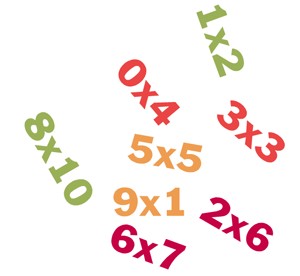Learning Multiplication tables is a foundational skill in mathematics that extends far beyond the classroom. From primary school to everyday life, a solid grasp of times tables is indispensable. Initially, students typically focus on the 1, 2, 3, 4, 5, and 10 times tables. As they progress, the 6, 7, 8, 9, 11, and 12 times tables, along with mixed order practice, become the next crucial steps in mastering multiplication.
While some children naturally grasp multiplication with ease, others may find it more challenging. Consistent practice is key to embedding these essential facts into long-term memory. Effective strategies can significantly simplify the learning process. One such trick is the commutative property of multiplication; understanding that 4 x 9 is equivalent to 9 x 4 can make problem-solving less daunting. Often, utilizing known times tables to solve more complex ones is beneficial. For example, to calculate 6 x 7, breaking it down into (5 x 7) + (1 x 7) can simplify the process. Similarly, 4 x 7 can be approached as (5 x 7) – (1 x 7).
Why dedicate so much effort to learning multiplication? Times tables are not confined to early education; they are pervasive throughout higher levels of schooling and in practical, real-world scenarios. Although they may not always appear explicitly as “times tables” in advanced mathematical problems, they are the underlying building blocks. Furthermore, proficiency in multiplication is invaluable in daily life, enabling quick calculations in situations such as shopping at a market or managing finances. For those seeking resources and effective methods for learning multiplication, websites like Timestables.com offer valuable support.
 Children learning times table with cloud visualization
Children learning times table with cloud visualization
The 5-Step Plan to Conquer Multiplication
Timestables.com has developed a 5-step plan, an innovative and efficient method designed to help students learn multiplication tables effectively. This approach has been successfully implemented and endorsed by educators in various schools. The steps are structured to provide a progressive learning experience:
- Step 1a: View, Read Aloud, and Repeat: Familiarize yourself with each times table by visually studying it, verbally reciting it, and repeating the process to initiate memorization.
- Step 1b: Sequential Fill-In: Practice recalling times tables in order by filling in the answers sequentially and immediately checking for accuracy to reinforce correct responses.
- Step 2: Drag and Drop Matching: Engage in interactive exercises where you drag the correct answers to match the multiplication questions, enhancing recognition and recall.
- Step 3: Mixed Questions Fill-In: Test your knowledge with mixed-order multiplication questions, filling in the answers and verifying them to ensure comprehensive understanding.
- Step 4: Multiple Choice Reinforcement: Utilize multiple-choice questions to approach multiplication from different angles, solidifying your understanding and improving response accuracy.
- Step 5: Knowledge Proof and Diploma: Demonstrate mastery of all times tables by completing a final assessment to earn a diploma, celebrating your achievement in learning multiplication.
Upon completing the 5-step plan, further enhance your skills with engaging activities such as memory games and printable worksheets available on Timestables.com. Additional training methods include tempo tests, one-minute drills, and interactive times tables games, all designed to make learning multiplication both effective and enjoyable. For optimal results, it is recommended to dedicate approximately 15 minutes daily to these exercises.
Frequently Asked Questions About Learning Multiplication
How can I speed up learning multiplication tables?
Adopt a strategic approach by learning in manageable segments. Begin with simpler tables like 10s, 2s, and 5s. Employ techniques such as skip counting, repeated addition, and consistent daily practice of about 15 minutes to maximize long-term retention and fluency in multiplication.
What is considered the most challenging times table?
The 7 times table is often cited as the most difficult to master. This is partly attributed to 7 being a prime number, which results in less discernible patterns in its multiples until you reach 10 x 7. Within the times tables, the question “6 times 8” is frequently pinpointed as the single hardest fact to recall.
Which times table is the easiest to learn?
The 10 times table is generally regarded as the easiest to learn. A key characteristic is that all multiples of 10 end in zero, providing a simple visual and numerical pattern. Following closely in ease are the 5 and 2 times tables, which also exhibit straightforward patterns that aid in memorization and recall when learning multiplication.
Practice Your Times Tables Online for Free
Multiplication tables are a cornerstone of mathematical proficiency, and Timestables.com is designed as an accessible platform to facilitate quick and easy learning. Practicing times tables online at Timestables.com offers a user-friendly experience. The multiplication games are designed to be clear and straightforward, allowing users to start practicing immediately. Simply select a specific times table to begin. Fill in the answers directly on the screen and click ‘check’ to receive instant feedback on your accuracy. The platform also supports practicing multiple times tables in a single session, enabling comprehensive testing of your overall multiplication knowledge.
To further enhance interactive learning, Timestables.com provides free multiplication games. These include engaging options like an answer-dragging game and a table balloons game, adding an element of fun to the process of learning multiplication.
Mastery of multiplication tables is fundamental for future mathematical studies. Ensuring a thorough understanding now will lay a strong foundation for more advanced calculations in the years to come.
Looking for more math practice? Visit Mathdiploma.com to explore addition, subtraction, multiplication, division, and much more!
For those interested in fractions, Fractionsweb.com offers a wealth of exercises on simplifying, adding, subtracting, dividing, and multiplying fractions. Discover fraction games, worksheets, and structured 5-step plans to support your learning journey.